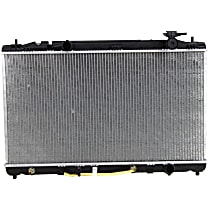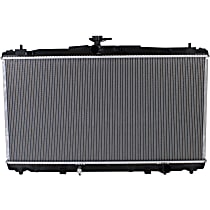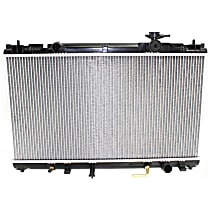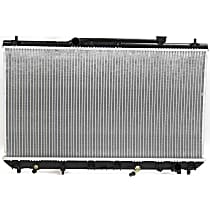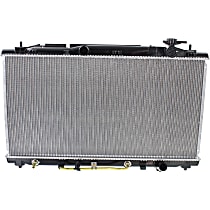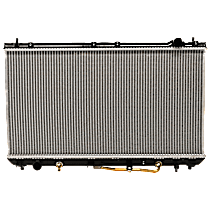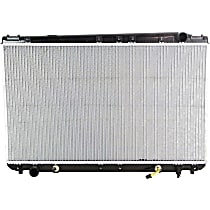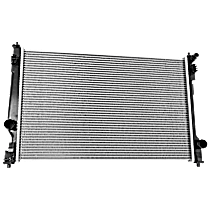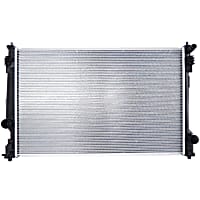{
"lazyNodes": false,
"abFitnotesFlag": false,
"abCrawlReviews": false,
"productOptionsCookie": false,
"orderDelayFlag": false,
"skipSessionCookie": false,
"covidMessage": false,
"fullTitleCookie": false,
"nrLoggerCookie": false,
"checkoutReviewCookie": false,
"productOptionSeqCookie": false,
"maintenanceFlag": false,
"bufferETACookie": false,
"multiShippingDiscountFlag": false,
"newFitmentFlag": false,
"surveyOptInFlag": false,
"crossSellFlag": false,
"skuMappingFlag": false,
"paySplitCookie": false,
"callDisableFlag": false,
"zipPaymentFlag": "u",
"hassleFreeReturn": false,
"lifetimeReplacement": false,
"cpn_off": false
}Toyota Camry Radiators
Shop Catalog
![]() WARNING: This product can expose you to chemicals including Lead and lead compounds, which is known to the State of California to cause cancer and birth defects or other reproductive harm. For more information go to www.P65Warnings.ca.gov.
WARNING: This product can expose you to chemicals including Lead and lead compounds, which is known to the State of California to cause cancer and birth defects or other reproductive harm. For more information go to www.P65Warnings.ca.gov.
![]() WARNING: This product can expose you to chemicals including Lead and lead compounds, which is known to the State of California to cause cancer and birth defects or other reproductive harm. For more information go to www.P65Warnings.ca.gov.
WARNING: This product can expose you to chemicals including Lead and lead compounds, which is known to the State of California to cause cancer and birth defects or other reproductive harm. For more information go to www.P65Warnings.ca.gov.
![]() WARNING: This product can expose you to chemicals including Lead and lead compounds, which is known to the State of California to cause cancer and birth defects or other reproductive harm. For more information go to www.P65Warnings.ca.gov.
WARNING: This product can expose you to chemicals including Lead and lead compounds, which is known to the State of California to cause cancer and birth defects or other reproductive harm. For more information go to www.P65Warnings.ca.gov.
![]() WARNING: This product can expose you to chemicals including Lead and lead compounds, which is known to the State of California to cause cancer and birth defects or other reproductive harm. For more information go to www.P65Warnings.ca.gov.
WARNING: This product can expose you to chemicals including Lead and lead compounds, which is known to the State of California to cause cancer and birth defects or other reproductive harm. For more information go to www.P65Warnings.ca.gov.
![]() WARNING: This product can expose you to chemicals including Lead and lead compounds, which is known to the State of California to cause cancer and birth defects or other reproductive harm. For more information go to www.P65Warnings.ca.gov.
WARNING: This product can expose you to chemicals including Lead and lead compounds, which is known to the State of California to cause cancer and birth defects or other reproductive harm. For more information go to www.P65Warnings.ca.gov.
![]() WARNING: This product can expose you to chemicals including Lead and lead compounds, which is known to the State of California to cause cancer and birth defects or other reproductive harm. For more information go to www.P65Warnings.ca.gov.
WARNING: This product can expose you to chemicals including Lead and lead compounds, which is known to the State of California to cause cancer and birth defects or other reproductive harm. For more information go to www.P65Warnings.ca.gov.
![]() WARNING: This product can expose you to chemicals including Lead and lead compounds, which is known to the State of California to cause cancer and birth defects or other reproductive harm. For more information go to www.P65Warnings.ca.gov.
WARNING: This product can expose you to chemicals including Lead and lead compounds, which is known to the State of California to cause cancer and birth defects or other reproductive harm. For more information go to www.P65Warnings.ca.gov.
![]() WARNING: This product can expose you to chemicals including Lead and lead compounds, which is known to the State of California to cause cancer and birth defects or other reproductive harm. For more information go to www.P65Warnings.ca.gov.
WARNING: This product can expose you to chemicals including Lead and lead compounds, which is known to the State of California to cause cancer and birth defects or other reproductive harm. For more information go to www.P65Warnings.ca.gov.
![]() WARNING: This product can expose you to chemicals including Lead and lead compounds, which is known to the State of California to cause cancer and birth defects or other reproductive harm. For more information go to www.P65Warnings.ca.gov.
WARNING: This product can expose you to chemicals including Lead and lead compounds, which is known to the State of California to cause cancer and birth defects or other reproductive harm. For more information go to www.P65Warnings.ca.gov.
![]() WARNING: This product can expose you to chemicals including Lead and lead compounds, which is known to the State of California to cause cancer and birth defects or other reproductive harm. For more information go to www.P65Warnings.ca.gov.
WARNING: This product can expose you to chemicals including Lead and lead compounds, which is known to the State of California to cause cancer and birth defects or other reproductive harm. For more information go to www.P65Warnings.ca.gov.
![]() WARNING: This product can expose you to chemicals including Lead and lead compounds, which is known to the State of California to cause cancer and birth defects or other reproductive harm. For more information go to www.P65Warnings.ca.gov.
WARNING: This product can expose you to chemicals including Lead and lead compounds, which is known to the State of California to cause cancer and birth defects or other reproductive harm. For more information go to www.P65Warnings.ca.gov.
![]() WARNING: This product can expose you to chemicals including Lead and lead compounds, which is known to the State of California to cause cancer and birth defects or other reproductive harm. For more information go to www.P65Warnings.ca.gov.
WARNING: This product can expose you to chemicals including Lead and lead compounds, which is known to the State of California to cause cancer and birth defects or other reproductive harm. For more information go to www.P65Warnings.ca.gov.
![]() WARNING: This product can expose you to chemicals including Lead and lead compounds, which is known to the State of California to cause cancer and birth defects or other reproductive harm. For more information go to www.P65Warnings.ca.gov.
WARNING: This product can expose you to chemicals including Lead and lead compounds, which is known to the State of California to cause cancer and birth defects or other reproductive harm. For more information go to www.P65Warnings.ca.gov.
![]() WARNING: This product can expose you to chemicals including Lead and lead compounds, which is known to the State of California to cause cancer and birth defects or other reproductive harm. For more information go to www.P65Warnings.ca.gov.
WARNING: This product can expose you to chemicals including Lead and lead compounds, which is known to the State of California to cause cancer and birth defects or other reproductive harm. For more information go to www.P65Warnings.ca.gov.
![]() WARNING: This product can expose you to chemicals including Lead and lead compounds, which is known to the State of California to cause cancer and birth defects or other reproductive harm. For more information go to www.P65Warnings.ca.gov.
WARNING: This product can expose you to chemicals including Lead and lead compounds, which is known to the State of California to cause cancer and birth defects or other reproductive harm. For more information go to www.P65Warnings.ca.gov.
Top Rated Products
Customer Guides
Troubleshooting Tips for your Toyota Camry Radiator
Your Toyota Camry's radiator is the main component of the vehicle's cooling system, which is responsible in keeping the engine in the right temperature. So when this part wears out, it could cause the engine to overheat. If lately you've been noticing that your hood is becoming hotter than the usual, might as well check your radiator and the other components of the cooling system for signs of premature wear. Here are some tips on how to understand and troubleshoot your car radiator better:
Frequent engine overheating
This is the common complaint of car owners when it comes to their radiators. If your car's temperature is remarkably higher when you're driving at 55 miles per hour or more, check if your coolant level is enough. Overheating is typically caused by a loss of coolant, which could be due to a leak in one of the hoses in the cooling system or in the radiator. Also, once the coolant seems to be dirty in color, it might be contaminated by other substances or another kind of coolant that make it unable to do its job properly. In this case, the engine cannot operate efficiently since there is not enough supply of coolant to begin with.
Coolant leaks
Are you sick and tired of seeing a puddle of colored liquid underneath your vehicle every single day? This is usually caused by a radiator leak. Try smelling a sample of the liquid to confirm if it is indeed a coolant leak. Coolants come in many colors like orange and green, among others. If the radiator seems to have no damage, you can then check the hoses for cracks. Also, check the coolant level in the radiator. If it is too low, then you should refill it immediately to avoid overheating. We advise that you use a 50/50 mixture of water and coolant for optimum results.
Rusty radiator
The radiator is prone to corrosion, especially if you don't regularly perform a radiator flush. Rust could accumulate within the radiator and cause it to fail. Always ensure that you flush the radiator at least once a year to keep it in good condition.
Summary
- The Toyota Camry made its debut in 1983. The first-generation Camry was a front-wheel drive. Since then, the Camry has evolved into different styles and trims. It has continued to become one of the best selling cars in America.
- A radiator consists of a large metal structure, with tubes and small fins. It is usually located near the cooling fan assembly and front grille of your car. Using the process of convection, the coolant is cooled by outside air coming from the car’s cooling fan and grille.
- A Toyota Camry usually has an aluminum radiator core installed with plastic tanks. A Toyota Camry OEM replacement radiator usually costs around $50 to $100.
- If you notice coolant leaks or if your vehicle frequently overheats, it is time to have your vehicle checked by a trusted mechanic.
The Toyota Camry made its debut in 1983. However, did you know that the Toyota Camry was not the first car to carry this nameplate? The name “Camry” was originally used by a four-door sedan that was released on January 1980—the Celica Camry. The Celica Camry is a sedan version of the popular Celica coupes and hatchbacks released in 1979. It was not long when Toyota decided to split it off into two model lines. The first Camry was a 1983.5 model with two body styles-- a sedan and a hatchback. Unlike the sporty Celica, the first-generation Camry was a front-wheel drive. Since then, the Camry has evolved into different styles and trims. It has continued to become one of the best selling cars in America.
Any vehicle, including your Toyota Camry, cannot run at its best performance without a fully functioning cooling system. One of the important components of your engine’s cooling system is a radiator.
What is a radiator?
A radiator consists of a rectangular metal structure, with tubes and small fins. It is usually located near the cooling fan assembly and front grille of your car. This structure is integral to the engine’s cooling process. To explain what the radiator’s role is in the engine’s cooling process, we would have to discuss the engine’s cooling system.
The Coolant
An engine’s cooling system would not work without coolant or antifreeze. This liquid is contained in a reservoir that is mounted in the engine bay. The main role of coolant or antifreeze is to draw heat away from the engine by way of convection. It is usually made from either ethylene glycol or propylene glycol. Some coolants also contain corrosion inhibitors that help prevent rust inside the engine block and radiator.
Engine’s Cooling Process
The coolant from the reservoir flows to the engine block through a hose, with the help of the water pump. As the coolant absorbs heat from the engine, the thermostat opens at a specified temperature allowing the coolant to then flow through a series of hoses to the radiator. Whenever a vehicle is in motion, a constant flow of air enters through the car’s front grille and passess through the radiator. Using the process of convection, the coolant is cooled by outside air coming from the car’s cooling fan and wind produced by the vehicle’s movement. The metal fins make it possible for the air to pass through the radiator core and cool the coolant. This process will continually repeat itself for as long as your engine is running.
Aside from the radiator core and fins, one important part of a radiator is the cap. It also allows the coolant to expand and contract while maintaining the pressure inside the engine’s cooling system.
A radiator can be classified by how many cores it has. For example, one-core, two-core or three-core radiators. The core refers to the central part of the radiator where the metal fins are located. The specifications of your radiator will greatly depend on your car’s year, make and model.
Types of Radiators
Aluminum-Plastic Radiators
Although copper is a much better heat conductor than aluminum, they are heavy and expensive. Because of this, car manufacturers replaced copper radiators with plastic and aluminum. An aluminum-plastic radiator is typically made of an aluminum core and plastic tanks.
A Toyota Camry usually has an aluminum-plastic radiator installed. The 2002-2006 Toyota Camry, for example, is equipped with a 1-row aluminum core with a plastic tank.
Aluminum Radiators
The core and tank of an aluminum radiator is constructed using only aluminum-based materials. It generally costs less than copper and brass making it a reasonable alternative. This type of radiator is usually built for high-performance cars.
How much does a Toyota Camry Radiator cost?
A Toyota Camry OEM replacement radiator usually costs around $50 to $100. It is usually sold as an individual part. Prices will depend on your car’s year and model.
There have been eight generations of Toyota Camry since 1983. To assure that your getting the most accurate fit for your vehicle, input the correct year, make and model into our search engine.
When should you replace your radiator?
Here are some of the major symptoms to look for to detect a failing radiator:
Rust and coolant leaks
The reason why a majority of radiators malfunction is because of rust. Rust can clog the radiator causing leaks. One of the most obvious signs that your radiator is failing is a coolant leak. Coolant will leak onto the floor either at the front or center portion of your vehicle. Your low coolant light might constantly trigger even when you are constantly filling out your coolant tank.
Overheating
Always check your temperature gauge. If you observe that the temperature of your car is rising rapidly, you may have an issue with your radiator. Remember that overheating may cause long term damage to your engine. It may put unnecessary stress on your engine causing damage to rings, pistons and rod bearings.
Before replacing your radiator, make sure you take all precautions to ensure your safety. Be sure that the engine is cool before doing anything to any of the cooling system components. This is to avoid the coolant burning you when you drain the system. If you are unsure with any of the steps required to replace your radiator, please consult your trusted mechanic.
Summary
- While the Camry prides itself on reliability, some of its components will have to be replaced due to regular wear and tear. One of these components is the radiator.
- Radiators usually fail around 80,000 miles, although there are cases when the radiator has failed earlier.
- Common symptoms of a failing radiator include: cracks and corrosion in the radiator body, leaking coolant, bent radiator fins, and engine overheating.
- The usual OE Toyota Camry Radiator replacement cost ranges from $50 to $100. On the other hand, performance radiator replacements can cost anywhere from $150 to over $800.
The Toyota Camry is a roomy sedan that promises safety, comfort, and peace of mind. The Camry was initially manufactured in 1982 as a compact or narrow-body sedan, but it has since evolved to become the mid-size sedan that it is today.
With more than 300,000 Camrys sold in the US yearly, it’s not surprising to see the high demand for Toyota Camry components too. While the Camry prides itself on reliability, some of its components will have to be replaced due to regular wear and tear. One of these components is the radiator.
Symptoms of a Failing Toyota Camry Radiator
The radiator is one of those components that would need replacement earlier on in your car’s life. Many radiators across various makes and models fail after around 80,000 miles. Of course, there are cases when radiators fail earlier than this, so it’s important to know the signs that your radiator is going bad.
Here are some common symptoms of a failing radiator:
Cracks
Most radiators are made of plastic and metal components. As the radiator goes through wear and tear and continuous exposure to the elements, the plastic parts can develop cracks. Cracks in your radiator means that you need to replace it as soon as possible.
Corrosion
Just as the plastic parts of your radiator can crack over time, the metal parts are susceptible to rust damage too. When your radiator’s metal parts become corroded, rust and other debris can mix with the coolant fluid and become radiator sludge. You need to replace your radiator when this happens.
Leaks
Leaking coolant is a direct result of your radiator having cracks or rust damage. Your coolant must be enclosed in the radiator at all times, so any signs of leaking coolant fluid on and around the radiator means that the integrity of the radiator has been compromised. If you discover a Toyota Camry radiator leak, get your radiator replaced as soon as possible.
Bent or Damaged Fins
Another visible sign of a bad radiator is fin damage. When a big portion of the radiator's fins become bent or mashed together, it’s time to replace the radiator.
Overheating
Your radiator is one of the major components of your vehicle’s cooling system, so failure of this part will definitely result in your engine overheating.
When your radiator begins to show any sign of failing, repair or replace it as soon as possible. Ignoring a damaged radiator puts your safety at risk. On top of that, a bad radiator can potentially cause damage to other vital components of your vehicle as well including your engine.
OE Replacement vs Performance Toyota Camry Radiator
The stock radiator on the Toyota Camry is designed for daily driving on paved roads. For most people, an OE replacement radiator, which functions exactly the same as a factory-issued radiator, is enough. However, if you use your Camry for some heavy-duty applications including towing or long drives, you might want to invest in a performance radiator. Compared to stock radiators which are made of metal and plastic, performance radiators typically have an all-aluminum build.
How Much to Replace the Radiator in a Toyota Camry
The usual OE Toyota Camry Radiator replacement cost ranges from $50 to $100. On the other hand, performance radiator replacements can cost anywhere from $150 to over $800. To get an accurate price, make sure to search for your specific vehicle. For instance, a ‘2009 Toyota Camry radiator’ would be a better search term than simply ‘Toyota Camry radiator.’
Getting your car stuck in the middle of the road with an overheated engine is one of your worst nightmares as a driver. This wastes your time and you need a lot of effort to get through it. What you can do to prevent this from happening is to keep your car components in good condition. The radiator, which is responsible in keeping your car's engine in a safe operating temperature, is one of the most important components that you shouldn't miss whenever you're having your car checked. For easy tips on how to take care of your radiator, here's what you can do:
Perform a radiator flush annually.
As small particles of dirt and rust build up on the radiator, it could cause clogging and wearing out if not given attention. This can cause the engine to overheat, since the radiator cannot function properly. A radiator flush is a quick and cheap way to clean your vehicle's clogged cooling system. All you need is a radiator flush solution and a fresh coolant to refill the radiator afterwards. We recommend that you perform this flush every year or as soon as you notice that your radiator needs cleaning.
Check the cooling system for leaks.
One of the major causes of overheating is a mistreated leak in the cooling system. Common parts that are vulnerable to crack and to leak are hoses, heater core, head gaskets, thermostat, and radiator. When one of these parts starts leaking the coolant, the engine is at risk of overheating due to the loss of the antifreeze. A visual inspection of the entire cooling system, followed by a pressure test of it and the radiator cap should be done regularly to ensure that there is no room for the coolant to escape.
Keep the coolant in its proper level.
Before you drive your car, make sure that the radiator has the right amount of coolant needed for it to function properly. The coolant tends to escape when the radiator overheats. If you suspect a leak on the cooling system since the level of the coolant easily decreases, then you should check for holes or cracks. Remember to clean and drain the radiator first before pouring in a fresh coolant.
Is it wise to upgrade a Camry's fully functional stock radiator?
There's a saying that goes, "If it ain't broke, don't fix it." The same goes for the Toyota Camry's radiator. It does a sufficient job of keeping the car cool and will usually last the vehicle's lifetime. However, performance radiators may be considered if the engine is being upgraded since it may need more cooling power.
What are the ways to determine the source of a radiator leak? What should be done after the leak source is discovered?
If the radiator seems to be losing fluid as fast as it is being replaced, then it most likely has a leak. The source of the leak has to be discovered first. It can be found by visually inspecting the radiator while looking out for deposits of the colored fluid. Pressure test kits are also available and will let you fill the radiator with air before it is submerged under water. The air inside the radiator will escape in the form of air bubbles; the source of these bubbles will then indicate the location of the leak. Additives may be used to fix minor leaks in the radiator while more significant ones can be welded shut. If those don't do the trick, replacing the radiator will be necessary.
What is radiator flush and how often should it be done?
After quite some time, rust, dirt and other deposits will form and collect in your radiator. If these solid particles continue to grow unabated, they may block the tubes of the radiator, greatly decreasing the rate with which heat is released from your engine compartment. An overheating engine isn't a remote possibility when this happens. To stop the buildup of these solid deposits, the radiator has to be flushed at least once a year.

